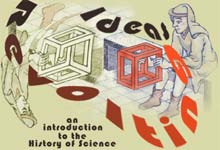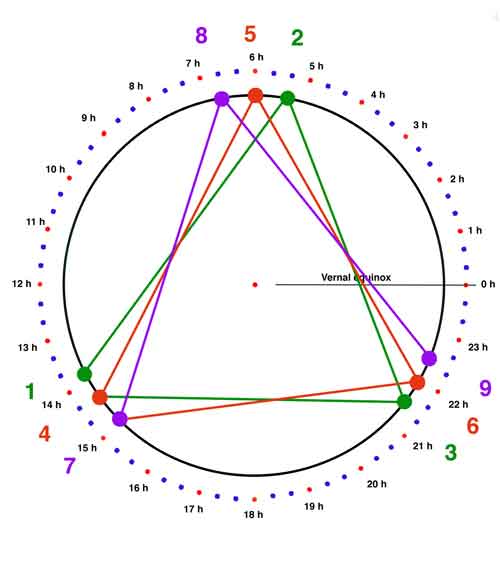
University of California, Irvine
Instructor: Dr. Barbara J. Becker

|
|
|
|
|
by Guillaume du Bartas (1544-1590)
from The Apology for Raimond de Sebonde
(1580)
[Natural] philosophy is nothing but sophisticated poetry.... Just as women use false teeth when their real ones drop out, and in place of a natural complexion lay on a manufactured one, and round out their figures with cotton stuffing, so ... science pays us with hypotheses which it confesses are pure invention. These epicycles with which astronomy moves the stars are merely the best devices it can contrive.... It was the stars and the heavens that were in motion for three thousand years. Or so everyone believed.... Now, in our time, Copernicus has so firmly established [that the earth moves, not the stars] that it serves everything we can observe astronomically. What shall we conclude from this, except that it is hardly worth while to heat ourselves up over one or the other? Who knows but what in a thousand years from now a third opinion will not supplant them both? [As Lucretius has written (Book V, On the Nature of Things:] Thus time as it goes round changes the seasons of things. That which was in esteem, falls at length into utter disrepute; and then another thing mounts up and issues out of its degraded state and every day is more and more coveted and blossoms forth high in honor when discovered and is in marvellous repute with men. from Theater of Universal Nature
(1597)
No one in his sense, or imbued with the slightest knowledge of physics, will ever think that the earth, heavy and unwieldy from its own weight and mass, staggers up and down around its own center and that of the sun; for at the slightest jar of the earth, we would see cities and fortresses, towns and mountains thrown down.... For if the earth were to be moved, neither an arrow shot straight up, nor a stone dropped from the top of a tower would fall perpendicularly, but either ahead or behind.... Lastly, all things on finding places suitable to their natures, remain there, as Aristotle writes. Since therefore the earth has been allotted a place fitting its nature, it cannot be whirled around by other motion than its own.
|
|
|
1559-1562 |
attended University of Copenhagen |
1566 |
participated in duel in which he lost part of his nose |
1572 |
observed New Star in the constellation Cassiopeia
concluded it is not an atmospheric phenomenon, but rather is located in the celestial realm |
1575 |
attended coronation of Holy Roman Emperor, Rudolph II
forged friendship that would prove useful later |
1576 |
awarded island of Hveen by Danish king
established scientific research center at Uraniborg acquired array of fine astronomical instruments (including his renowned mural quadrant) with which he carries out years of painstaking observation and celestial mapping thanks to royal patronage, able to embark on long-term observation projects:
|
1577 |
observed comet
concluded it is also located in the celestial realm |
1597 |
after disagreement with Danish king, left Denmark for court of Rudolph II in Prague |
|
|
A Verbal Self-Portrait That man has in every way a dog-like nature. His appearance is that of a little lap-dog. His body is agile, wiry and well-proportioned.... |
|
Notable Events in Kepler's Life |
1571 (May 16, 4.37 am) |
conceived |
1571 (Dec 27, 2.30 pm) |
born at Weil-der-Stadt |
1589 |
entered University of Tubingen |
1591 |
received Master's degree began work as mathematics instructor at Gratz |
1595 |
formulated "fourth law"--
six planetary orbits are nested in five Platonic solids |
|
|
Conjunctions of Saturn and Jupiter (1300-1490) |
|
|
|
|
hrs mins |
|
|
|
|
|
|
|
|
|
|
|
|
|
|
|
|
|
|
|
|
|
|
|
|
|
|
|
|
|
|
Gemini | 6 45 |
| 9. 4-1464 | Aquarius | 22 30 |
| 10. 11-1484 | Libra/Scorpio | 15 30 |
![]()
![]()
![]()
Conjunctions of Saturn and Jupiter (1300-1490)
depicted graphically

![]()
![]()
![]()
Conjunctions of Saturn and Jupiter (1570-1770)
|
|
|
hrs mins |
|
|
|
|
|
|
|
|
|
|
|
|
|
|
|
|
|
|
|
|
|
|
|
|
|
|
|
|
| 8. 1-1723 | Scorpio/Sagittarius | 17 40 |
| 9. 8-1742 | Leo | 10 00 |
| 10. 3-1762 | Pisces | 0 50 |
![]()
![]()
![]()
Conjunctions of Saturn and Jupiter (1570-1770)
depicted graphically by Kepler

|
||||||||||||||||||||||||
|
Notable Events in Kepler's Life (cont'd) |
|
1596 |
published Mysterium Cosmographicum (Cosmic Mystery) |
1599 |
accepted position at Prague with Tycho |
1600 |
began work on problem of Mars' orbit |
1601 |
death of Tycho |
1601-3 |
formulated "second law"--
planets sweep out equal areas in equal times |
1603 |
formulated "first law"--
planets move in elliptical orbits |
1604 |
observed another New Star in the constellation Ophiuchus |
1609 |
published Astronomia Nova (New Astronomy)
|
Why should I mince my words? The truth of Nature, which I had rejected and chased away, returned by stealth through the backdoor, disguising itself to be accepted. That is to say, I laid [the original equation] aside, and fell back on ellipses, believing that this was quite a different hypothesis, whereas the two ... are one and the same.I thought and searched, until I went nearly mad, for a reason why the planet preferred an elliptical orbit [to mine]....
Ah, what a foolish bird I have been!
It is therefore clear that the traditional doctrine about gravity is erroneous....Gravity is the mutual bodily tendency between like bodies towards unity or contact (of which kind the magnetic force also is), so that the earth draws a stone much more than the stone draws the earth....
Suppose the earth were in the center of the world. Heavy bodies would be attracted to it, not because it is in the center, but because it is a like body. It follows that regardless where we place the earth ... heavy bodies will always seek it....
|
|
Notable Events in Kepler's Life (cont'd) |
|
1618 |
formulated "third law"--
T2/R3 = constant, for all satellites orbiting any given central body |
1619 |
published Harmonice Mundi (Harmony
of the World)
|
1621 |
published Epitome Astronomiæ Copernicanæ (Epitome
of Copernican Astronomy)
|
1627 |
published Rudolphine Tables |
|
|
|
|
|